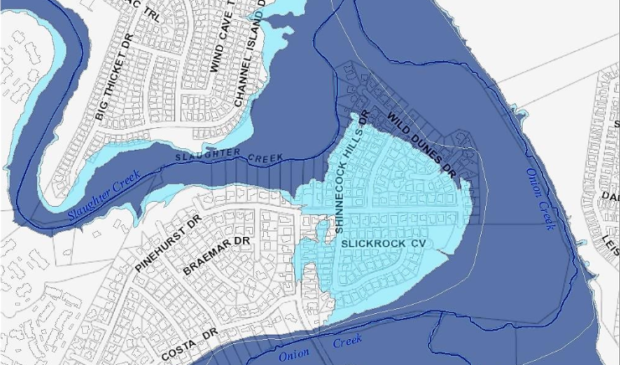County could save time and money by hiring drainage consultant
Wednesday, June 26, 2019 by
Ryan Thornton The Travis County Public Works Division has devised a way to save from $25,000 to $35,000 on construction projects that are not expected to have an impact on the existing flood plain elevations.
Per the county’s regulations, projects must be reviewed anytime they fall within the limits of the Federal Emergency Management Agency flood plain, even when a design engineer has shown the infrastructure would not negatively impact the flood plain.
Staff told the Commissioners Court Tuesday that the department could dramatically cut costs for such projects by working with an independent consultant – instead of FEMA – when verifying that the flood plain will remain the same.
If approved, projects demonstrating an impact to the flood plain would still be sent through the existing review process.
“It’s FEMA’s flood plain so we’ve always felt that FEMA should weigh in on whether a project has any effect on the flood plain,” said Stacey Scheffel, permit program manager and flood plain administrator with Transportation and Natural Resources.
Looking forward, however, staff said both the high cost of $30,000 to $40,000 as well as the minimum waiting period of six months for each review is putting a strain on county operations. In addition to the typical waiting period of nine to 12 months, the process cannot begin until the design work is nearly complete.
“It’s really killing the time frame of some of our (capital improvement) projects,” Scheffel said.
In contrast, a private consultant could do the same job for roughly $5,000 to $6,000 and the department could simultaneously shave over a year from its 2017-2022 Bond Program projects schedule.
“We’re also looking at an escalation cost annually of, thumbnail, 7 percent,” noted County Judge Sarah Eckhardt. “So in a million-dollar project, 7 percent would be $70,000.”
Since FEMA ultimately defines the flood plain maps, moving forward with projects without the agency’s review carries a minor risk that the county could be liable for any errors.
Scheffel assured the commissioners that the department could minimize that risk by hiring an engineering firm that demonstrates comprehensive knowledge of FEMA’s method and criteria for determining the impact of construction projects.
That consultant would be charged with reviewing the engineering work done for county projects, including by private engineering firms. Commissioner Brigid Shea questioned the need for that redundancy, which she likened to hiring “someone to check their homework.”
“This is the irony of the county,” said Morgan Cotten, director of Public Works. “We have us doing projects and we have a regulatory group who oversees that and so it’s giving them the support to be able to concur with the findings of the engineers.”
Eckhardt added that the purpose of having the extra review is also to assure the federal government that the county isn’t coloring its analyses to its benefit. Besides the fact that “it would be completely against our philosophy and our raison d’être as a governmental entity to shade the truth for our projects,” Eckhardt said the negative consequences would only catch up with the county downstream.
However, given the county’s reputation, including its voluntary adoption of the Atlas 14 rainfall intensities, Eckhardt said it’s unlikely that the federal government would “look askance” on the decision to work with a hired firm rather than FEMA.
No action was taken Tuesday, but Cotten said the department could return to court to further discuss the rationale for the change or could provide additional information when bringing the court a professional service agreement for consideration.
“We’d like to get ourselves in a position sooner than later one way or the other,” he said.
Map courtesy of the city of Austin.
The Austin Monitor’s work is made possible by donations from the community. Though our reporting covers donors from time to time, we are careful to keep business and editorial efforts separate while maintaining transparency. A complete list of donors is available here, and our code of ethics is explained here.
You're a community leader
And we’re honored you look to us for serious, in-depth news. You know a strong community needs local and dedicated watchdog reporting. We’re here for you and that won’t change. Now will you take the powerful next step and support our nonprofit news organization?










